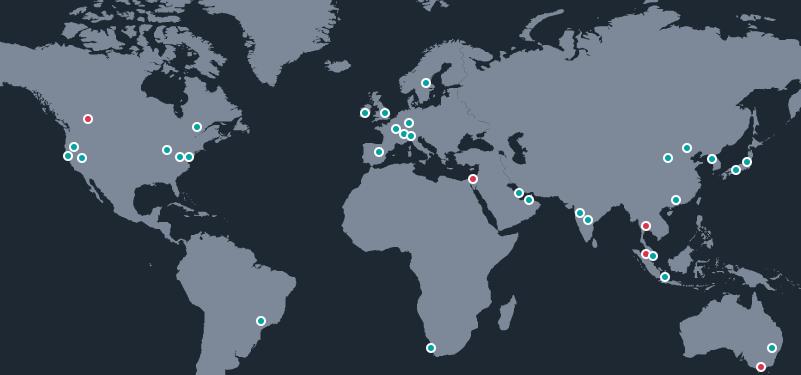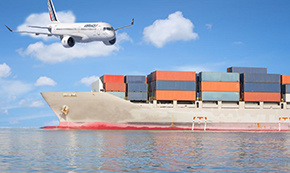All categories >
What do you need to know about domestic to foreign parcels by international shipping (international shipping is divided into two ways)
Categories:
Time of issue:
2024-04-13 14:55
国际海运(International Ocean Freight)
It is the most important mode of transport in international trade. More than 2/3 of the total volume of international trade, most of China's import and export goods are transported by sea.
The main characteristics of international shipping are low cost, long time, suitable for large shipments of foreign orders.

International shipping in two ways:
1. Shipping container (CY): one ticket, one cabinet or more than one ticket.
2. Shipping LCL (CFS): more than three votes are collected and one cabinet is assembled.
There are several types of containers:
1.20 feet:
The size is 6*2.2*2.3, theoretical 30 cubic meters, actual 25-27CBM,18-23 tons.
2.20-foot weighting:
The size is 6*2.2*2.3, theoretical 30 cubic meters, actual 25-27CBM,25-28 tons.
3, 40 feet:
The size is 12*2.2*2.3, the theory is 60 cubic meters, the actual is 55-57CBM,18-23 tons.
4.40-foot height: 12*2.2*2.8 in size, 73 cubic meters in theory, 68-70CBM in practice, 18-23 tons. The above are the main cabinet types, and others are less used 45 feet, stool cabinets, open top cabinets, refrigerated cabinets, etc.
The time limit of international shipping: the time limit of international shipping is determined by the destination, the date of the ship and so on.
For example, if you go to Los Angeles (LA) in the United States from Thursday to Saturday, you will arrive in 14 days. If the ship is cut off on Friday and left on Sunday, it will arrive in 11 days.
However, it takes 15 days to reach Oakland (OAK) for the same American city, which leaves on Friday and Sunday.
For example, to Naples (NAPLES) in Italy, if it is a ship from Hong Kong on Monday and Tuesday, it will arrive in 18 days. If it is a ship from Hong Kong from Friday to Sunday, it will arrive in 21 days.
However, it takes 25 days to reach Barcelona, Spain, which is also a European city and leaves from Friday to Sunday.
Operation flow of whole cabinet
1, sales: dangerous goods (chemicals) of the contract, must require customers to provide details of their products, including the correct.
Chinese and English names, composition lists, levels of violation, etc., and must consult the carrier (shipowner) in advance whether to carry.
2, quotation: according to the customer's specific shipping requirements: including the characteristics of the goods, port of destination, shipping requirements, delivery conditions, and other special requirements, to make a preliminary quotation to the customer;
Piece fee towing fee (other agency fee); approximate shipping date information is also required in the quotation sheet; and it is important not to guarantee the shipping date to the customer;
3, the power of attorney: the customer according to the "power of attorney" content, fill in the specific information, complete and clear, the "power of attorney" content.
4, booking space and trailer: strict requirements and pay close attention to the timeliness of the trailer company;
5. lifting and loading of cabinets: the complete set of customs declaration documents shall be complete, and the customer shall affix the official seal of his company to the relevant documents with specific requirements;
6. Customs declaration and release: submit a full set of documents to the customs, the customs shall examine the documents and examine the goods and documents according to the customs declaration data, conduct spot checks or self-examination by the freight forwarder (at his own risk), and collect taxes according to the category of goods, in accordance with the provisions of national laws, and fill in the verification form, so that after the goods are exported, the owner of the goods will be refunded. If the unqualified return document is reviewed again.
7. Handover with shipowners and shippers: after handing over the release slip to the customs, ask the shipowner (on behalf of) for the name and voyage data of the first-leg ship to prepare the bill of lading; Check the original bill of lading information with the shipowner (on behalf of), deliver the freight to the shipowner (on behalf of) and receive the shipowner's bill of lading (MB/L); Check the bill of lading with the shipowner (on behalf of lading), arrange the procedure of electric discharge;
8, the issuance of bills of lading: in general, after the goods are loaded back to the field, then confirm with the customer the specific requirements of the bill of lading, is the issuance of the owner's bill of lading (MB/L) or the bill of lading (HB/L), at the same time, the customer is required to provide a copy of the contents of the bill of lading information;
9. Charge freight
10, destination exchange order pick-up
World famous shipping company
1 Maersk
There are hundreds of du agencies in more than 100 countries around the world, with more than 60,000 employees and services all over the world. In addition to the shipping industry, the Group's diversified business scope covers a wide range of logistics, oil and gas exploration and production, shipbuilding, aviation, industrial production, supermarket retail and IT.
2. Mediterranean shipping
Business network all over the world. In the 1970 s, Mediterranean Shipping focused on developing shipping services between Africa and the Mediterranean. By 1985, Mediterranean Shipping expanded its business to Europe and later opened pan-Atlantic routes.
3. Dafei Group
At present, Dafei Group operates 244 container ships worldwide, including 71 of its own ships with a loading capacity of 500,000TEUS. It has set up 420 branches and offices in 126 countries and regions around the world, employs 10200 people worldwide, and its tracks cover 216 ports around the world.
4. Evergreen Group
One of the top ten consortia in Taiwan, with total assets of more than 100 billion yuan. Evergreen Shipping Company is the world's largest shipping company, with container transportation routes throughout Asia, America, Europe, Central and South America, the Red Sea, the Mediterranean and other places.
5. Harpa Lloyd Shipping
Also translated as "Hapg-Lloth". It has more than 80 routes around the world, has about 200 modern ships, nearly 5 million containers (TEUs), and has more than 6800 employees in 320 regions and 130 countries around the world.
6. China Shipping Group
China Shipping Group Corporation was established on the basis of five enterprises directly under the Ministry of Communications, including Shanghai Shipping Group Corporation, Guangzhou Shipping Group Co., Ltd., Dalian Shipping Group Corporation, China Seafarers' Foreign Technical Service Corporation and China Communications Shipping Company. Headquartered in Shanghai.
7. American Presidential Ship APL
The full name of the AMERICAN PRESIDENT LINES was originally an American shipping company with a history of 150 years. It was later annexed by NOL (Oriental Sea Emperor) in 1997, but it still used the name APL.
8. Hanjin Group
Entrepreneur Zhao Zhongxun personally created. Hanjin Enterprise Group includes 12 large-scale enterprises, including Korean Air, Hanjin Shipping and Hanjin heavy Industry, with 25000 employees.
9. COSCO, China
10. Japanese postal shipping NYK
What's the charge for shipping?
Generally, those involved in billing tons and CBM are LCL or bulk carriers.
Different shipping companies, freight forwarders, docks and warehouses have different methods of calculating sea freight for LCL. Some are charged according to the volume of the goods, and some are charged according to the weight of the goods.
A, the whole box: the whole box freight is divided into three parts, the total freight = the sum of the three parts.
1. Basic Freight Basic Freight = Unit Basic Freight × Number of Boxes
2. Port surcharge Port surcharge = unit port surcharge x number of whole containers
3. Fuel surcharge Fuel surcharge = unit fuel surcharge × number of whole containers
B, LCL: LCL freight only basic freight, divided into volume and weight calculation in two ways:
1, by volume, X1 = unit basic freight (MTQ) x total volume.
2. Calculated by weight, X2 = basic freight per unit (TNE)× total gross weight
The calculation method of billable tons (RT) is usually: choose the largest count between volume and weight. This is also common in air transport.
Later, freight forwarders charge according to CBM, that is, they charge according to volume (it is estimated that it is appropriate to charge according to volume after selecting a large plan).










